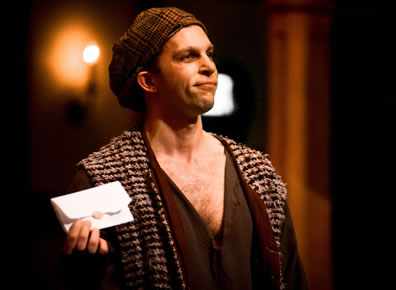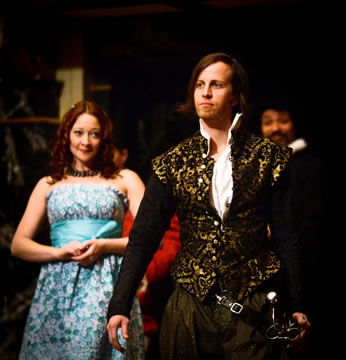The Servant of Two Masters
Lifting Laughter to the Level of High Art
By Carlo Goldoni, adapted by E.J. Dent, edited by Allison Glenzer
American Shakespeare Center, Blackfriars Playhouse, Staunton, Va.
Friday, February 7, 2014, D–6&7 (front middle stalls)
Actors' Renaissance Season

Gregory Jon Phelps as Truffaldino in The Servant of Two Masters. at the Blackfriars Playhouse Photo by Pat Jarrett, American Shakespeare Center.
Sometimes, in the fine art form known as theater, the greatest socially redeeming quality is laughter. The script may have originated on the streets of Renaissance Italy more than 350 yeas ago; the theater may be replicated on one of the two most famous playhouses in all of history; the company may be classically trained actors specializing in Shakespeare and his contemporaries; and all of this leads to one grand goal: to get us to bust a gut.
And bust guts we do in the American Shakespeare Company's production of the commedia dell'arte classic The Servant of Two Masters. This is the second entry in this the company's 10th annual Actors' Renaissance Season during which the troupe of actors without directors and costume designers (and on a Blackfriars Playhouse stage without sets) mount plays in a matter of days. It's a production process especially suited to the conventions of commedia dell'arte in which, in its original form, traveling actors used plot outlines and stock characters to create on-the-spot street theater.
Though Carlo Goldoni's 1743 script is pure commedia dell'arte, this production is not. Ironically, that is its strength, and I say that harboring a fondness for that particular form of theater. Commedia dell'arte is purposely over-the-top, with actors wearing masks and engaging in exaggerated gestures and cartoonish violence. Visually, there is no subtlety, and its hyperphysicality is not for all tastes. However, it can be uproarious fun as the cast improvises its way through the play, riffing on contemporary events and the audience itself. The line between actor and character and between the unreality of the play and the reality of the performance is purposely blurred—blended might be the better verb—obliterating any fourth wall and making for some of the most spontaneous theater this side of Whose Line Is It Anyway? From the improv aspect to emoting in masks, true commedia dell'arte requires special training and experience, the kind we have seen splendidly manifested in the performances of the Faction of Fools in Washington, D.C., and in an authentic commedia dell'arte production of The Servant of Two Masters at the Shakespeare Theatre Company two years ago.
The ASC Actors' Renaissance Season troupe, as a whole, has no such training nor can the actors afford the time or have the funds to come up with masks (they are responsible for finding or building their own props). So, using a public domain translation by Edward J. Dent edited into a crisp two hours (plus two intermissions) by company member Allison Glenzer (who also plays the maid Smeraldina), the actors take this occasion to showcase their own considerable individual and ensemble acting skills. It's not what they say that's so funny, it's how they act it that generates the laughs. It's how Glenzer calls Truffaldino "the dirty little man," how John Harrell as Pantalone walks on stage with a huge money bag dangling from his crotch, how he and René Thornton Jr. as Dr. Lombardi snipe at each other, how Thornton's Lombardi resorts to haughtily rendered Latin, how Sarah Fallon as Clarice pouts in her love for Silvio and pouts in her hate for Silvio, and how Chris Johnston as Silvio adds some six or seven syllables to the F every time he says the name of his rival, Federigo Rasponi.
At the center of it all is Gregory Jon Phelps as Truffaldino, the titular servant of two masters. Always hungry and always in need of money, Truffaldino schemes his way from one lie to the next as he attends to Beatrice (Abbi Hawk) and Florindo (Jonathan Holtzman). These two lovers on the run—he for killing Beatrice's brother, Federigo, in a duel, and she now disguised as Federigo to secure her dead brother's wealth—separately come to Venice unaware they are sharing the same inn, let alone the same servant. Truffaldino is the stock centerpiece clown of commedia dell'arte, a Sad Sack sort of fellow who schemes his way to a happy ending and takes the audience into his confidence. Phelps seems to channel the Marx Brothers, en total, as his muse for this role and can even turn chewing bread into a hilarious joke, one we eagerly return to later in the play.
This is a tour de force performance by Phelps, a longtime ASC member who has raised his game to the upper echelons of acting and character development over the past year. Every step, every gesture, every expression, every line-reading, every slight tilt of his head, every slight shift of his posture, every ever-so-slight nuance of his being is deftly delivered to ensnare the audience's sympathy in his plight, and we laugh all the while. When we watch Truffaldino making one particularly egregious mistake, the whole audience automatically says some variation on "Uh-oh," and Phelps looks out to us in alarm and then an expression of "What?" Then he continues on with what he's doing. Truffaldino is a two-joke role that can quickly grow tiresome, yet we can't get enough of Phelps playing it.

Chris Johnston as Silvio under the admiring eyes of Clarice (Sarah Fallon) in the American Shakespeare Center production of The Servant of Two Masters at the Blackfriars Playhouse. Photo by Pat Jarrett, American Shakespeare Center.
Coming at the comedy from a different direction but just as effectively is Johnston. His Silvio is a coward braggart, but Johnston takes this stock character to a richly multidimensional level. He establishes Silvio's whole-hearted love for Clarice in the opening scene, an affection that never wavers and pushes him to reach way, way beyond his incompetence. That incompetence is not obvious at first: Johnston's Silvio is every bit the cavalier swordsman in manners and bearing, but under this superserious form, Johnston slyly establishes the character's comic foibles in the way he simply hasn't mastered the ability to draw his sword. Silvio is a victim of circumstances and, consequently, a plot among people who actually are looking out for him, and Johnston plays the clumsy dupe as something so heroic that by the time he petulantly stands by while Clarice threatens to kill herself, he knows the audience is in his corner, making the scene funnier still.
Much of the confusion that drives the plot comes from characters directing Truffaldino to give something, retrieve something, or tell something to his master. Which master? Invariably, he gets the wrong master. So, Johnston's Silvio, preparing to do battle with Ffffffederigo, in fact finds himself facing Florindo, whom we already know to be an expert duelist. Fortunately, a fatal case of mistaken identity is avoided here, and we are later treated to the more rewarding circumstance of mistaken identity when Silvio encounters the real Ffffffederigo, who is, in fact, not Federigo but his sister, Beatrice. Hawk makes the most of Beatrice's part-playing, confidently striding and bearing herself as Federigo but revealing herself as a frightened woman carrying out a dangerous scam while pining for her own true love. Hawk and Johnston have choreographed their swordfight to be both dangerous and funny, with Johnston parrying both skill and incompetence at the same time, and Hawk's Beatrice forgetting she's not really a man when she resorts to a low blow and gets one in return.
So, if you are coming to the Blackfriars Playhouse to see a Shakespearean acting company perform a commedia dell'arte classic, sorry, you won't see history, Shakespeare, or even commedia dell'arte. But you will see skilled actors mastering the art of comedy. And you will bust a gut.
Eric Minton
February 10, 2014
Comment: e-mail editorial@shakespeareances.com
Start a discussion in the Bardroom



 Find additional Shakespeareances
Find additional Shakespeareances